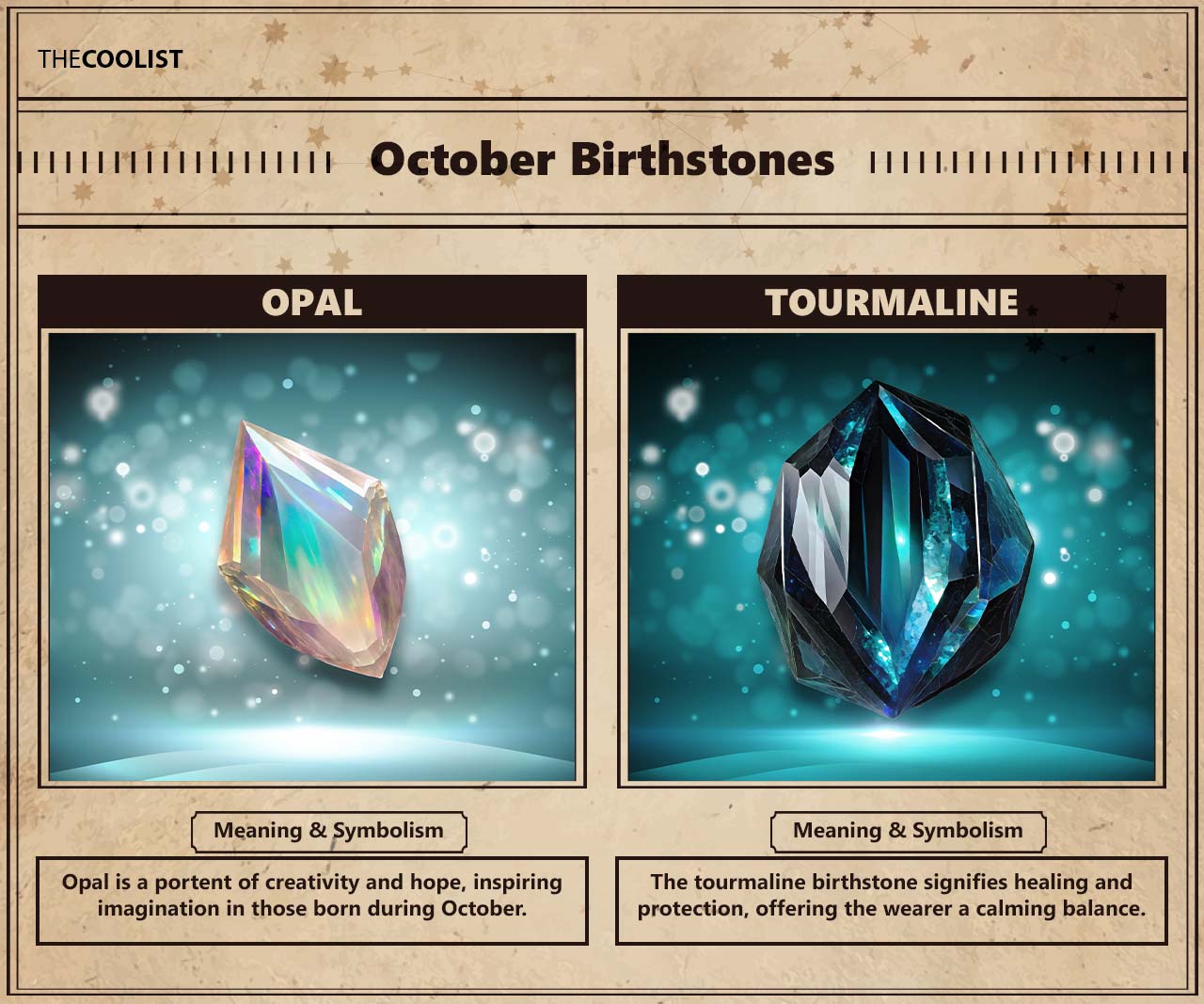The October birthstone choices are the opal and tourmaline, symbolizing hopeful self-development, creativity, grounding, and reconciliation. October birthstone choices showcase the energetic profile and characteristics of people born in the month. Individuals born in October can embrace the opal and tourmaline to enhance their style and benefit from the stones’ inherent traits.

Opals are renowned for their captivating play of color, displaying a spectrum of hues that symbolize creativity, emotional depth, and the beauty of change. This gemstone is treasured for its ability to inspire and uplift, reflecting October-born individuals’ dynamic and imaginative spirit. Similarly, tourmaline, known for its wide color range, offers a variety of choices, from vibrant pinks to deep greens. Each tourmaline coloring holds its unique significance, aligning with the adaptability and resilience of those born in October.
Tourmaline is also appreciated for its grounding and protective qualities, providing stability and emotional strength. The gemstone’s versatility in color and form makes it a popular choice for various jewelry pieces, catering to diverse tastes and styles. The Jewelers of America, recognizing the significance and popularity of these gemstones, have included both opal and tourmaline in the modern list of birthstones, reflecting the diverse characteristics and preferences of October-born individuals.
Below, discover the meanings of opal and tourmaline and how their qualities can enrich the lives of those who wear them.
What does the October birthstone mean?
The October birthstones represent self-development, creativity, grounding, and reconciliation. Opals are celebrated for symbolizing the fluidity and beauty of life’s changes. Their dynamic interplay of colors represents hope in the face of the unpredictability of life and the personal growth that comes from embracing change. This aspect of the opal encourages October-born individuals, often seeking stability, to remain open to new experiences and life’s diverse paths.
Creativity and inspiration are central to the opal’s symbolism. The stone’s vivid colors and unique patterns are believed to ignite the imagination and encourage artistic expression. For those seeking a boost in creativity, the presence of an opal is thought to stimulate innovative ideas and artistic endeavors.
Tourmaline offers a sense of grounding, especially in varieties like black tourmaline. It’s said to anchor individuals in the present moment, which is particularly beneficial for those born in October who might struggle with overthinking. Wearing black tourmaline connects one with the Earth’s energies, promoting stability and a strong sense of self. For example, Philip Permutt’s book The Complete Guide to Crystal Chakra Healing explains that tourmaline resonates with all chakras to amplify spiritual connectivity.
Additionally, tourmaline embodies the concept of reconciliation. It’s associated with the ability to forgive and move forward, lightening the soul and aiding in healing. Combined with opal’s transformative symbolism, this tourmaline quality provides a harmonious blend of attributes for October-born individuals, embracing change, fostering creativity, ensuring stability, and encouraging emotional healing.

What is the difference between modern and traditional October birthstones?
Modern and traditional October birthstones differ in color combinations, and modern lists don’t feature aquamarine. Traditional October birthstones, such as aquamarine, offer soothing blue hues, symbolizing calmness and clarity. Aquamarine was historically favored for its serene and cleansing qualities. However, aquamarine is no longer featured as an October birthstone in more modern lists.
The modern October birthstones of opal and tourmaline present various colors. Opal is renowned for its unique play-of-color, displaying a spectrum of hues within a single stone, while tourmaline is celebrated for its diversity, available in virtually every color from vibrant pinks to rich greens. This shift to opal and tourmaline in contemporary times reflects a broader appreciation for color variety and the gemstones’ distinct characteristics, moving away from traditional stones like aquamarine’s more uniform color palette.
What are the alternate birthstones for October?
The alternate birthstones for October are agate, jasper, and aquamarine. Agate is revered as the guardian angel stone, symbolizing protection and strength. It is believed to provide emotional balance and resilience, making it a meaningful choice for those seeking stability and inner peace. Jasper is recognized as the Tibetan stone and is valued for its nurturing and grounding qualities. It is often associated with tranquility and spiritual connection, aligning with the introspective and reflective nature of the fall season.
Lastly, aquamarine is a traditional alternative known for its soothing blue hues that evoke calmness and clarity. This stone is thought to enhance communication and provide a sense of serenity, making it an apt choice for those born in October. Together, these stones offer a range of aesthetic and symbolic options beyond the primary birthstones of opal and tourmaline, catering to diverse preferences and attributes.
Is there an October zodiac birthstone?
Yes, October has two zodiac birthstones, opal for Libra and topaz for Scorpio. Opal aligns with Libra’s energy, a sign characterized by balance, harmony, and a love for beauty. Librans wearing opal are thought to benefit from the gemstone’s ability to enhance creativity, emotional intelligence, and artistic expression, qualities that resonate deeply with this air sign’s nature. The mesmerizing play of color in opals mirrors Libra’s multifaceted personality and its pursuit of aesthetic and relational harmony.
Pink tourmaline, with its vibrant and deep hues, is believed to resonate with Scorpio’s powerful emotional spectrum and quest for truth and authenticity. Scorpios wearing pink tourmalines may find it amplifies their emotional resilience and fosters a sense of empowerment. Both opal and pink tourmaline complement the distinct personalities of their respective zodiac signs in October, enhancing the unique traits of Libras and Scorpios.
What color is October’s birthstone?
October’s birthstone coloring ranges from an interplay of colors, from the opal to the multi-colored tourmaline. The most distinguishable trait of the opal birthstone is its unique interplay of colors, which exhibits a broad spectrum of hues. The color of October’s birthstone ranges from blue, green, red, yellow, and other colors. Similarly, tourmaline comes in a wide range of colors, including pink and green, blue (indicolite), and multi-colored verities. For example, watermelon tourmaline displays both pink and green hues.
What is the October birthstone crystal shape?
The following four shapes and formations reflect each October birthstone’s crystal qualities.
- Emerald cut: The emerald cut highlights opal’s color with its rectangular shape, while in tourmaline, it enhances the gem’s color and clarity through its long lines and stepped facets.
- Oval: Oval-cut opals maximize the surface area for color display and are complemented by the shape, whereas oval-cut tourmalines showcase their brilliance and color in a balanced, elegant manner.
- Round: Round-cut opals are rare but can vividly display the stone’s fire, and in tourmalines, they emphasize brilliance and color saturation, which is ideal for smaller stones in various jewelry types.
- Cabochons: Opals are cut into cabochons to enhance their iridescence, while cabochon-cut tourmalines can highlight the depth of color, especially in stones with special optical effects like cat’s eye or asterism.
Tourmaline has a trigonal crystal system with elongated columnar crystals forming slender, three-sided prisms. The structure contributes to its unique pleochroism, displaying varied colors from different angles. In contrast, opal is an amorphous mineraloid, lacking a crystalline structure, characterized by a random arrangement of silica spheres, which results in its distinctive play-of-color. While tourmaline crystals typically develop triangular cross-sections and striated faces, opal’s lack of a regular crystal lattice gives it a unique formation process and appearance, distinguishing it from crystalline gemstones like tourmaline.
What’s the history of the October birthstone?
Each October birthstone has a rich history beginning in antiquity, representing good luck and protection. Opal has been treasured throughout history for its unique play of color and mesmerizing appearance. Historically, opals were believed to hold great power and were often associated with good luck and hope. Ancient Romans valued opal as a symbol of purity and love, while in the Middle Ages, it was considered a stone that could provide great luck because it was believed to possess all the virtues of each gemstone color represented in the color spectrum of the opal.
Tourmaline, the modern October birthstone, also boasts a storied past. It was not until the 1800s that tourmaline was recognized as a distinct mineral species. Before this, its wide range of colors led to confusion with other gemstones, such as emeralds and rubies. The name “tourmaline” comes from the Sinhalese word “toramalli,” which means “stone with mixed colors.” This is particularly fitting as tourmaline is found in various colors, each thought to hold its unique property. For instance, pink tourmaline is believed to represent love and is often associated with creative artists.
Opal and tourmaline have been revered for their beauty and supposed mystical properties. Opals are known for their ability to display a whole rainbow of colors, and in some cultures, they were thought to bring the wearer the gift of prophecy or protection from disease. Tourmaline, with its array of colors, was similarly ascribed to various powers, such as protecting and healing.
The opal was certified as the October birthstone in 1912 when the Jewelers of America introduced a modern list of birthstones. Accordingly, the opal was officiated as the modern birthstone for October. Tourmaline was solidified as an October birthstone in the 19th century when it was recognized as a distinct mineral.
Where is the October birthstone found?
Each October birthstone is found worldwide, with prominent mining operations in Australia, South America, Asia, and Africa. Australia is a major producer of opals known for its high-quality black opals, particularly from the Lightning Ridge region in New South Wales. Other Australian opal fields include Coober Pedy in South Australia and Mint Abie in the Northern Territory. Ethiopian opals, including Welo opals, have received recognition for their vibrant interplay of colors. The Wolli Province is a notable opal-producing region. Mexico produces a variety of opals, with significant deposits found in regions such as Querétaro and Jalisco.
Comparatively, Brazil is a major producer of tourmaline, which comes in a wide range of colors, such as green, pink, and watermelon. Minas Gerais is a significant tourmaline-producing region. Afghanistan produces fine-quality tourmaline, including the desirable pink and green varieties. Nigeria contains various tourmaline colors, including pink, green, and bi-color stones. Mozambique is a notable producer of vivid red and pink tourmaline, including the sought-after rubellite variety.
October birthstone chart
Below is a chart that explains the October birthstones.
| October birthstones | |
| Modern | Opal and tourmaline |
| Traditional | Aquamarine |
| Zodiac | Opal (Libra) and topaz (Scorpio) |
| Meaning | Self-development, creativity, grounding, and reconciliation |
| Color | Multicolored and iridescent |
| Historical significance | Good luck and protection |
What are the October birthstone personality traits?
The following are five October birthstone personality traits attributed to the birthstones opal and tourmaline.
- Confidence: Tourmaline’s variety and strength inspire confidence, reflecting the self-assured nature of those born in October.
- Positivity: Opal’s play of color represents a positive outlook, mirroring October-born individuals’ optimistic attitude.
- Compassion: Opal is linked to compassion, a trait that resonates with October-born people’s empathetic and caring nature.
- Wisdom: The deep hues of tourmaline symbolize wisdom, akin to the thoughtful and insightful demeanor often seen in those born in October.
- Adaptability: Tourmaline’s color diversity signifies adaptability, characteristic of October-born individuals’ ability to adjust and thrive in varying circumstances.
Are there benefits to wearing an October birthstone?
Yes, wearing an October birthstone offers the following five benefits. Opals enhance creativity and inspiration, helping individuals conceptualize new ideas and channel their creative energies effectively. They further promote emotional stability, particularly valuable during stressful times, aiding individuals in navigating their emotions and fostering well-being.
Tourmaline is believed to act as a protective shield against negative energies, enhancing personal security and self-acceptance. Its variety of colors symbolizes adaptability, encouraging wearers to go with the flow and appreciate life’s nuances. For example, October aligns with the angel number 1010 and reflects encouragement to grow and adapt to new experiences.
Additionally, tourmaline is considered beneficial for healing, particularly in overcoming emotional challenges. It is said to connect with the heart chakra, facilitating the release of past burdens and promoting emotional liberation. Together, opal and tourmaline encompass a range of qualities from creative stimulation and emotional balance to protection, adaptability, and healing, making them valuable gemstones for those born in October.
What happens after wearing opal and tourmaline?
You’re more likely to experience greater creativity, maintain a positive outlook, and rebound from adversity after wearing opal and tourmaline. Firstly, wearing an opal birthstone stimulates the sacral chakra, which is responsible for sexuality, creative expression, and emotions. When this chakra is open with a surplus of energy flowing through, your motivation, passion, and sense of empowerment will shine through your creative projects.
Secondly, tourmaline and opal birthstones strengthen your resilience and ability to remain calm in the heat of the moment. One of the hardest lessons to learn in life is not allowing your emotions to control your reactions. This is why wearing opal and tourmaline is important in affirming this ability. Thirdly, wearing tourmaline means you’re more likely to rebound from adverse situations and the emotions associated with those experiences. Tourmaline lets its wearer let go and release what no longer serves them.
Who should wear opal and tourmaline?
People born in October or who want to embrace the qualities of opal and tourmaline should wear the stones. Opal is believed to be particularly beneficial for those born under the zodiac signs of Libra and Scorpio, resonating with traits like creativity and emotional depth. Tourmaline is known for its color diversity and offers varied symbolic benefits. For example, pink tourmaline is associated with love and emotional healing, black tourmaline with protection and grounding, and green tourmaline with growth and prosperity. These associations, rooted in cultural and metaphysical traditions, suggest that choosing to wear opal or tourmaline can be guided by personal preference, the gemstone’s aesthetic appeal, and its resonating symbolic meanings.
Is it bad luck to wear opal?
No, it is not bad luck to wear opals. The myth surrounding opals and bad luck dates back further than the 19th century and has more complex origins. One significant contributor to this superstition was the 1829 novel ”Anne of Geierstein” by Sir Walter Scott, where an opal brings misfortune to the main character, leading to a decline in the opal’s popularity. This fictional story, rather than a deliberate campaign by a diamond company, played a significant role in shaping public perceptions about opals.
Additionally, opals have been traditionally associated with good luck and have been prized in various cultures for their unique beauty. As the October birthstone, opals are considered particularly suitable for individuals born that month. The belief that October-born individuals benefit more from wearing opals is part of the lore surrounding birthstones, which holds symbolic and sentimental value rather than being based on scientific evidence.
| Further reading on birthstones | |||||||||||
| January | February | March | April | May | June | July | August | September | November | December | |

